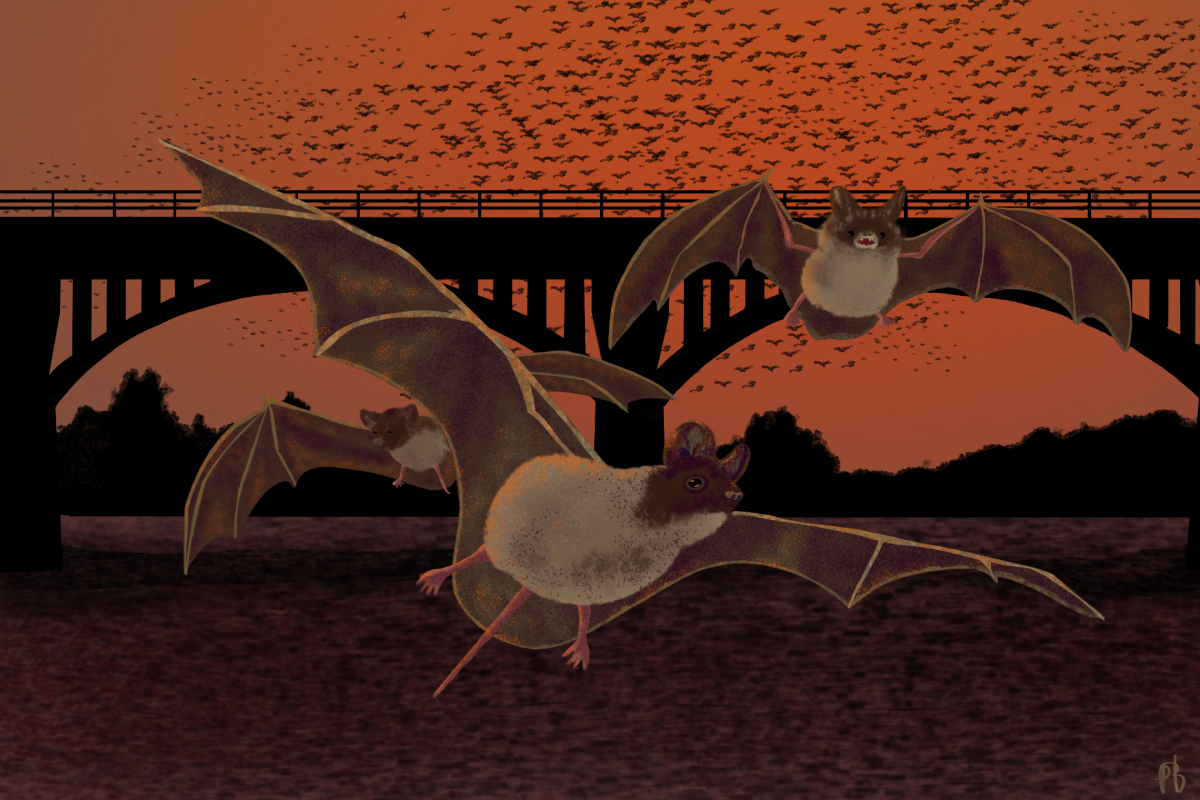Bats have become an iconic symbol of Austin, especially since the 1980s, when the Mexican free-tailed bat population began roosting under the Congress Avenue Bridge. Known as ‘Bat City,’ Austin attracts locals and tourists each summer to watch the bats’ nightly flights, making them a beloved sight for the community.
While bats are an important part of the city, they also play a vital role in the ecosystem. Bats help control insect populations and pollinate plants, making it crucial to protect them.
Habitat loss, disease, and human fear, however, threaten the Austin Bat population. Conservation efforts, though limited in Austin, aim to protect these animals and educate the public about their importance.
The Austin Bat Refuge, the only rehabilitation program in the area, is dedicated to caring for injured bats, while Merlin Tuttle’s Bat Conservation focuses on protecting habitats and raising awareness. Despite these efforts, bat populations still face significant challenges.
Melissa Donnelly, the science specialist with Merlin Tuttle’s Bat Conservation, highlighted how urban development in Austin adds to the pressure on bat populations.
“Urbanization and expansion are some of the primary threats to bats, especially in Austin,” Donnelly said. “Bats have been around for at least 50 million years, and they’ve adapted to urban environments, but we haven’t adapted to the idea of sharing space with wildlife yet.”
Fran Hutchins, director of the Bracken Cave Preserve at Bat Conservation International, stressed the impact urbanization has on bat habitats.
“Worldwide you have people cutting down rainforests or bulldozing. You know, a lot of bats live in trees, so when we knock down trees to put homes up and buildings…you’re destroying where they live,” Hutchins said.
Besides urbanization, Hutchins said white-nose syndrome, a deadly cold-loving fungal disease, is killing bat populations across North America by infecting them while they hibernate in caves during the winter.
“This fungus gets on their skin, and it eats into (it), and it’s an irritant,” Hutchins said. “When the bat wakes up to deal with this irritant, it’s burning off its fat reserves, and they’ll starve to death,”
Although the disease has severely impacted bat populations, Donnelly said there is hope.
“It’s endemic now, but bats are resilient,” Donnelly said. “While we can’t stop the spread entirely, what we can do is provide bats with more habitat and create conditions that allow them to thrive, helping them survive other stressors while they recover.”
Luckily, Dianna Odegard, co-founder of the Austin Bat Refuge, said that unlike tri-colored and cave myotis bats, the bats living in Austin and across Central Texas remain active year-round, avoiding the spread of white-nose syndrome as they do not hibernate.
Beyond habitat loss and disease, misinformation and fear surrounding bats continues to damage their reputation, challenging conservation efforts that try to protect them.
Odegard said that fear and false information causes people to harm bats, creating a unique danger for them in Austin and around the world.
Many misconceptions about bats contribute to this fear, like the belief that they carry rabies or drink human blood. Hutchins said this misconception is fueled largely by media that portray bats as small vampires, reinforcing negative stereotypes.
“A lot of people think the only thing bats eat is blood… which, you know, they don’t,” Hutchins said. “Most wild animals don’t want to have anything to do with us.”
Besides stereotypes, Odegard addressed myths about bats and rabies, explaining that most bats don’t contract the virus and aren’t carriers. She said that when bats do get rabies, they typically don’t survive.
Donnelly said that these ideas about rabies can be misleading because statistics are often skewed, as sick animals are captured and tested more frequently than healthy ones.
“When you find a bat in the open or on the ground, there’s usually something wrong,” Donnelly said. “But bats have been living safely alongside humans for a really long time.”
Despite the challenges bats face, organizations and initiatives dedicated to their conservation are working to build appreciation for these important animals.
The Austin Bat Refuge welcomes volunteers and donations, relying entirely on public support. Similarly, Merlin Tuttle’s Bat Conservation collaborates with Swift River Pecans to promote sustainable agriculture by installing bat boxes on farms and offering workshops focused on reducing pesticide use. Additionally, Bat Conservation International operates globally, owning and protecting caves and surrounding land in various regions across the world while also conducting research programs.
Residents can further contribute by refraining from trimming palm fronds that serve as bat roosts, and installing bat boxes to provide additional habitats for bats that have recently lost their homes.
Each organization emphasizes the importance of education, noting that one of the most effective ways to help bats is to share new information with those you know.
“We believe one of the most important things anyone can do to help bats is to learn about how important they are,” Odegard said. “Bats are fascinating, vital to our environment, valuable to our economy, and are harmless if simply left alone.”

































Margarita • Oct 26, 2024 at 1:39 pm
Love all the information very educational thanks for the awesome work in informing our community